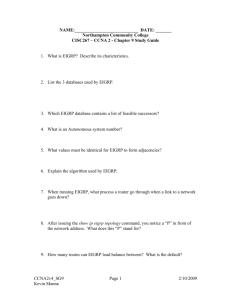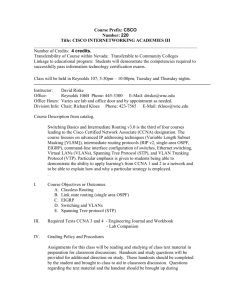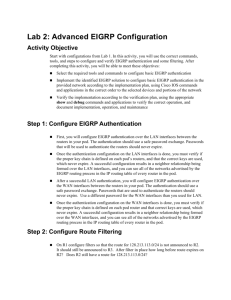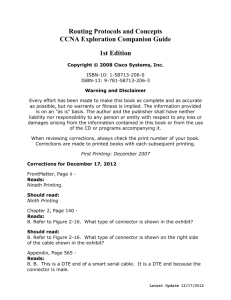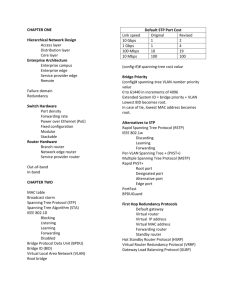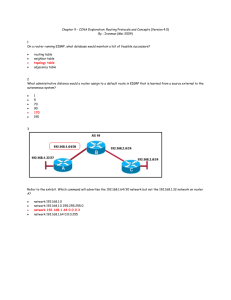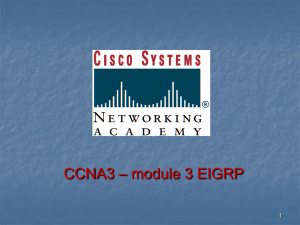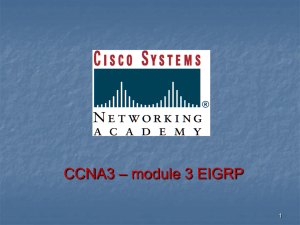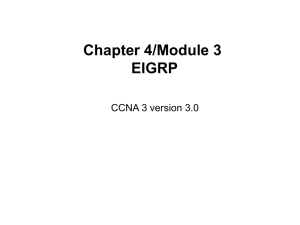CCNA: EIGRP CHEAT SHEET
advertisement
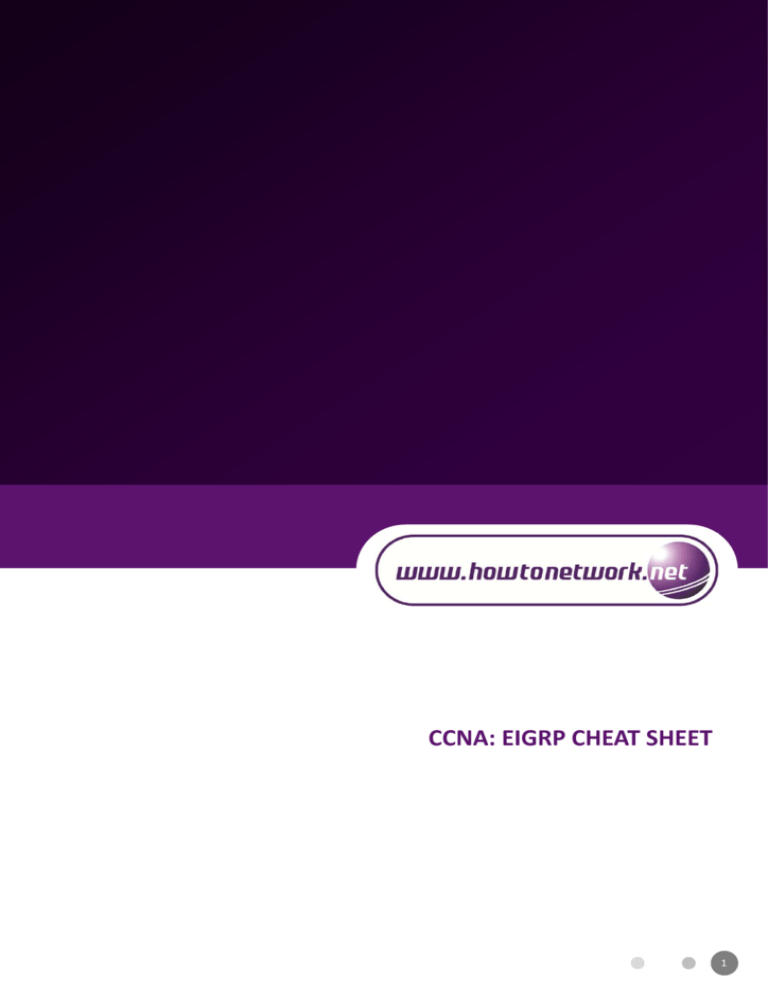
CCNA: EIGRP CHEAT SHEET 1 CCNA: EIGRP CHEAT SHEET Key Characteristics Router ID (RID) Type: Advance Distance Vector or Hybrid Algorithm: Diffusing Update Algorithm (DUAL) Standard: Cisco Propriety Administrative Distance: RID should be a valid IP address, not a 32-bit dotted decimal number Cisco Routers uses the following criteria to select a router ID: 1. Internal Routes = 90 2. External Routes = 170 3. Summary Routes = 5 Metric: Composite Transport Protocol/Protocol Number: IP/88 Routed Protocol Support: IP, IPX and AppleTalk Authentication: Yes (MD5 only) Supports VLSM and Route Summarization: Yes Fastest Convergence Metric Calculation EIGRP uses a composite metric. Composite metric consists of bandwidth, load, delay, reliability and MTU By default, only bandwidth and delay are considered Metric=256 x [(10^7/minimum-bandwidth) + cumulative delay] Bandwidth is in kbps and delay is in micro-seconds Minimum bandwidth represents least bandwidth along the entire route Cumulative Delay represents the sum of all delay values for all links in the route Neighbor Discovery EIGRP sends hellos on multicast address 224.0.0.10 to discover potential neighbors. Hellos are always use unreliable delivery To become neighbors EIGRP routers must be agree on the following parameters: 1. 2. 3. 4. Autonomous System (AS) number Same primary subnet Authentication (if used) K-values must match 1. RID configured with “router-id” command 2. If manual RID not configured, select the highest number IP address on any loopback interface in “up/up” state 3. If loopback interfaces not configured, select the highest number IP address on any non-loopback interface in “up/up” state Route Types and Preference Internal Routes: routes advertised within the same AS External Routes: routes imported from another routing domain or AS Internal Routes are denoted with “D” External Routes are denoted with “EX” Routes Preference: 1. Internal Routes (90) > External Routes (170) EIGRP Table Types EIGRP maintains three types of tables: 1. Neighbor Table: keeps state information regarding neighbors, and is displayed using the “show ip eigrp neighbors” command 2. Topology Table: EIGRP Update messages fill the routers’ EIGRP topology tables. Topology table can be displayed with “show ip eigrp topology” command 3. (IP) Routing Table: Based on the contents of the topology table, each router chooses its best routes and installs these routes in its respective IP routing table. The IP routing table is displayed with “show ip route” command Packet Types Hello: used in neighbor discovery/recovery process, are always multicast and use unreliable delivery (no acknowledgement is required) Acknowledgment: are hello packets without any data and are always unicast & use unreliable delivery Update: Convey route information. Updates are non-periodic, partial, bounded, can be unicast or multicast and use reliable delivery Query and Reply: used by DUAL finite state machine. Queries can be unicast or multicast and replies are always unicast, using RTP. Topology Exchange EIGRP exchanges topology updates on multicast address 224.0.0.10 using Reliable Transport Protocol (RTP) If an acknowledgment is not received for the multicast update, the update is then re-transmitted as unicast to the un-responsive neighbor. After 16 unicast re-transmission, the neighbor is declared dead EIGRP updates are: 1. Non-Periodic: updates are sent only when some topological or metric change has occurred 2. Partial: only relevant changes are advertised 3. Bounded: updates are sent to affecting neighbors 2 CCNA: EIGRP CHEAT SHEET Timers Hello Time: 5 seconds for link faster than T1 and 60 seconds for T1 and slower links Hold Time: 3 times the hello. 15 seconds for links faster than T1 and 180 seconds for T1 and slower links Smooth Round Trip Time (SRTT): the average time elapsed (in milliseconds) between the transmission of packet to neighbor and the receipt of acknowledge Retransmission Timeout (RTO): time between subsequent unicast messages. It is the time that router will wait for an acknowledgement after sending unicast packet sent after a multicast has failed DUAL Terms and Route Selection Adjacency: logical session between two neighbors over which route information is exchanged Reported Distance (RD): is the distance (metric) towards a destination as advertised by an upstream neighbor. Feasible Distance (FD): Lowest calculated distance (metric) to the destination from local router’s perspective. Some books/texts use Advertised Distance instead of Reported Distance. Successor: A particular route with the best metric is a successor. It may also refer to a router that is being used as the next-hop for that particular route. With two or more successors (routes) if FDs are the same, load balancing happens automatically Feasible Successor (FS): Backup router with loop-free path for a particular route. FS is a neighbor who’s Reported or Advertised Distance (AD/RD) is less than the current Feasible Distance (FD) for that particular route. Feasible Successor is one who meets the feasible condition Feasible Condition (FC): RD of a particular route from a neighbor which is not the current successor for that route must be less than the FD for that particular route. The logic is simple: if a neighbors metric for a route is less than mine, then I know the neighbor doesn't have a loop going through me Equal and Unequal Cost Load Balancing EIGRP support equal and unequal cost load balancing Equal cost load balancing is enabled by default. Routes with equal feasible distance are installed by default in the routing table Variance is used to achieve unequal cost load balancing. Default value for variance is: 1, which will cause the EIGRP to select the best/lowest cost path only Variance defines the multiplier by which a metric may differ from the lowest cost route. By default 4-paths are allowed but can be extended to 16-paths with “maximum-paths <path>” command Variance is given by: higher cost metric / lower cost metric Rule for Variance: 1. Load balance path should lead to successor or feasible successor (that is if it met the Feasibility Condition) Configuration Example: network statement and authentication 3 CCNA: EIGRP CHEAT SHEET Configuration Example: network statement and authentication Router R1: key chain EIGRP_KC key 1 key-string cisco ! interface loopback 0 ip address 10.1.1.1 255.255.255.255 ! interface serial 0/0 ip address 192.168.12.1 255.255.255.252 ip authentication eigrp 100 md5 ip authentication key-chain eigrp 100 EIGRP_KC ! router eigrp 100 no auto-summary network 192.168.12.0 network 10.1.1.0 Router R2: key chain EIGRP_KC key 1 key-string cisco ! interface loopback 0 ip address 10.2.2.2 255.255.255.255 ! interface serial 0/0 ip address 192.168.12.2 255.255.255.252 ip authentication eigrp 100 md5 ip authentication key-chain eigrp 100 EIGRP_KC ! router eigrp 100 no auto-summary network 192.168.12.0 network 10.2.2.0 R1#sh ip route | b Gateway Gateway of last resort is not set 192.168.12.0/30 is subnetted, 1 subnets 192.168.12.0 is directly connected, Serial0/0 10.0.0.0/32 is subnetted, 2 subnets D 10.2.2.2 [90/2297856] via 192.168.12.2, 00:00:14, Serial0/0 C 10.1.1.1 is directly connected, Loopback0 C Configuration Example: variance and unequal cost load balancing Router R1: interface loopback 0 ip address 10.1.1.1 255.255.255.255 ! interface serial 0/0 ip address 192.168.12.1 255.255.255.252 ! interface fastethernet0/0 ip address 192.168.21.1 255.255.255.252 ! router eigrp 100 variance 15 network 10.1.1.0 network 192.168.12.0 network 192.168.21.0 no auto-summary Router R2: interface loopback 0 ip address 10.2.2.2 255.255.255.255 ! interface serial 0/0 ip address 192.168.12.2 255.255.255.252 ! interface fastethernet0/0 ip address 192.168.21.2 255.255.255.252 ! router eigrp 100 variance 15 network 10.2.2.0 network 192.168.12.0 network 192.168.21.0 no auto-summary R1#sh ip route eigrp 10.0.0.0/32 is subnetted, 2 subnets D 10.2.2.2 [90/156160] via 192.168.21.2, 00:03:21, FastEthernet0/0 [90/2297856] via 192.168.12.2, 00:03:21, Serial0/0 R2#sh ip route eigrp 10.0.0.0/32 is subnetted, 2 subnets D 10.1.1.1 [90/156160] via 192.168.21.1, 00:03:06, FastEthernet0/0 [90/2297856] via 192.168.12.1, 00:03:06, Serial0/0 4 CCNA: EIGRP CHEAT SHEET Troubleshooting Command 1. 2. 3. 4. 5. 6. 7. show ip protocols show ip eigrp neighbors show ip eigrp interfaces show ip eigrp topology show ip route debug eigrp packets [hello | ack | query | reply | update] debug eigrp fsm 5
